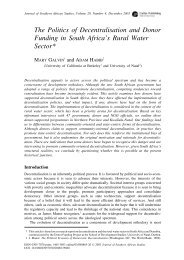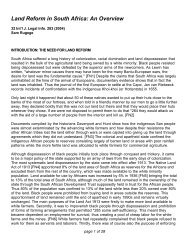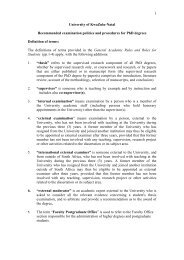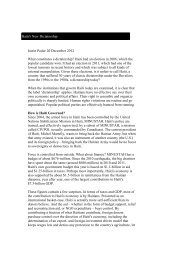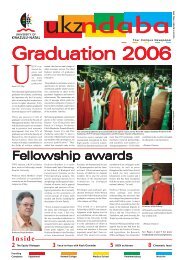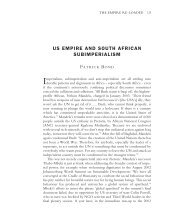Bell, Trevor : Unemployment in South Africa
Bell, Trevor : Unemployment in South Africa
Bell, Trevor : Unemployment in South Africa
Create successful ePaper yourself
Turn your PDF publications into a flip-book with our unique Google optimized e-Paper software.
Accord<strong>in</strong>g to this particular <strong>in</strong>dicator, the White unemployment rate rose<br />
strongly, with only m<strong>in</strong>or cyclical decl<strong>in</strong>es, from 2.4 per cent <strong>in</strong> 1918 to<br />
11.4 per cent <strong>in</strong> 1928, before the Great Depression, and then despite a<br />
drop <strong>in</strong> 1929, <strong>in</strong>creased two and a half fold to a peak of 27 per cent <strong>in</strong><br />
1933. Nothwithstand<strong>in</strong>g sharp decl<strong>in</strong>es thereafter, the unemployment rate<br />
amongst Whites on the eve of the Second World War was still higher than it<br />
had been <strong>in</strong> 1926, when the problem of poverty and unemployment was already<br />
considered a serious one1). That these figures reflect a very real,<br />
serious problem of unemployment amongst Whites which persisted over<br />
virtually two decades, seems to be <strong>in</strong>controvertible; and the possibility<br />
of a protracted period of high and ris<strong>in</strong>g unemployment (whether one calls<br />
it "cyclical" or "structural") is thus clear.<br />
Data comparable with those for the <strong>in</strong>ter-war years are not available for<br />
the period s<strong>in</strong>ce the Second World War. It is apparently not possible,<br />
therefore, to determ<strong>in</strong>e precisely how high today's unemployment rates <strong>in</strong><br />
<strong>South</strong> <strong>Africa</strong> are, relative to the 'twenties and 'thirties, even <strong>in</strong> the<br />
case of Whites. The rate of unemployment amongst Whites, Coloureds and<br />
Asians, harever, is almoat certa<strong>in</strong>ly lower today than it was <strong>in</strong> the <strong>in</strong>terwar<br />
years, and, <strong>in</strong>deed, it seems from evidence presented below that it is<br />
lower today than it was <strong>in</strong> 1961-1962, when it reached its highest level <strong>in</strong><br />
the post-war period. Nevertheless, s<strong>in</strong>ce the mid-1970s various studies<br />
have suggested not only that the unemployment rate <strong>in</strong> <strong>South</strong> <strong>Africa</strong> for the<br />
population as a whole is high compared with other countries, but that<br />
there is a tendency for it to rise secularly.<br />
These f<strong>in</strong>d<strong>in</strong>gs have been the subject of much controversy and <strong>in</strong> the rest<br />
of this section, therefore, we focus on the question whether the<br />
unemployment rate <strong>in</strong> <strong>South</strong> <strong>Africa</strong> is <strong>in</strong> fact subject to a ris<strong>in</strong>g secular<br />
trend.<br />
The pr<strong>in</strong>cipal available estimates of unemployment for the <strong>South</strong> <strong>Africa</strong>n<br />
population as a whole for the past two decades are those of Charles<br />
1) See, for <strong>in</strong>stance, Hobart Houghton and Daqut (19731 for excerpts from<br />
some contemporary analyses of the problem.




